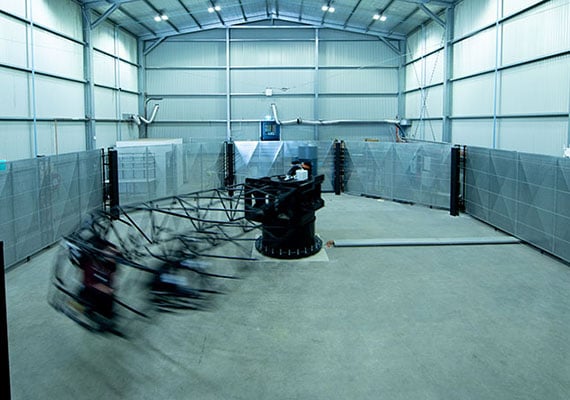
Safe training for aircrews and astronauts
CYCLONE allows aircrews and astronauts to experience training and emergency scenarios in a safe environment, putting people out of harm’s way and saving costs.
The world-leading researchers and facilities at Deakin’s Institute for Intelligent Systems Research and Innovation (IISRI) have put Australia at the forefront of aviation and space training technologies, thanks to a centrifuge system nicknamed CYCLONE. This motion simulator enables Australian pilots and astronauts to complete high levels of acceleration, also known as high-g, training safely.
Designed, built and tested at Deakin’s Waurn Ponds Campus, CYCLONE is Australia’s first high-G centrifuge platform that will safely train astronauts and Royal Australian Air Force pilots to cope with the high levels of acceleration (known as G-forces) associated with modern aircraft.
CYCLONE is a human-capable, low-cost, high-G centrifuge system activated by a rotating electric motor which acts as a counterweight for the arm structure.
The system will increase Australia’s air force capabilities in the area of air combat training by providing a platform for simulation and training in Australia, removing the need for Australian trainee pilots to travel overseas to complete high-G training.
CYCLONE is also designed for astronaut training, supporting the growth of Australia’s space industry since the launch of the Australian Space Agency in 2018.
Modern fighter jets have more power, speed, rapid acceleration and manoeuvrability than ever before. This increased performance exposes pilots to greater physical and psychological stress, which can lead to a Gravity-induced Loss of Consciousness (G-LOC). G-LOC threatens the aircrew lives, the mission and the multi-million-dollar aircraft. High-G training, using the CYCLONE program, improves aviators’ and astronauts’ tolerance of G-forces.
Centrifuge training, Anti-G Straining Manoeuvres (AGSM) and human physiological data monitoring system are required to prepare individuals to withstand G-forces. These all can be included in the training provided through the CYCLONE in order to advance Australian-based Aviation Medicine research.
The platform complements and extends cutting-edge research in advanced motion training platforms underway at IISRI.

CYCLONE allows aircrews and astronauts to experience training and emergency scenarios in a safe environment, putting people out of harm’s way and saving costs.
With the development of CYCLONE and launch of UMS: Universal Motion Simulation – a spin-off company established to commercialise motion simulation capability – Deakin has proven its capacity to translate world-class research into innovative and practical applications that solve real-world problems and benefit industry and society.
Located in Deakin’s advanced manufacturing innovation hub, ManuFutures, at the Waurn Ponds campus, UMS: Universal Motion Simulation is currently developing production techniques and processes, ahead of scale production and delivery to the defence industry for driver, pilot and sailor training.
The UMS company’s core Reconfigurable Driver Simulator (RDS) is a highly-dynamic motion platform consisting of a six-degree-of-freedom robotic arm, interchangeable replica vehicle cabins, haptically-enabled control devices and immersive simulation environments, featuring detailed vehicle dynamics and terrain modelling. The simulators will be capable of training army drivers in a range of vehicles, including the Boxer 8x8 CRV, M1A1 Abrams Main Battle Tank and future Infantry Fighting Vehicles.
In defence, space and aerospace, training aircrews in real life situations using actual aircraft is costly and potentially dangerous. Motion simulators, such as CYCLONE, can allow aircrews and astronauts to experience a range of training scenarios in a safe virtual environment, while improving competence in a wider variety of scenarios. In general, simulators are the safe and cost-effective tools for virtual prototyping, testing new land and air vehicle designs and conducting user behaviour analysis.
With the capability to generate up to 9G-centrifugal acceleration with a maximum onset rate of 5G/s, CYCLONE is a highly agile system that provides aircrews with multiple flight scenarios in a controlled environment. It can perform rapid manoeuvres with multi-axis motions at sustained high-G forces and rapid onset rates. Aircrews are taught Anti-G Straining Manoeuvres (AGSM), are able to practice breathing techniques and utilise anti-G suits in the CYCLONE.
The CYCLONE project has received significant support and funding from various sources. In 2020, a $260,000 Australian Government grant funded a feasibility study.
CYCLONE’s low-Cost Advanced Motion Training for Aircrew Safety and Human Performance is part of an ongoing Capability and Technology Demonstrator (CTD) program, managed and funded by the Federal Government through its Defence Innovation Hub.
In 2024, a $15,000 Defence Science Institute (DSI) grant was announced to develop assistive technology to develop an assistive technology to improve the performance of aircrews within CYCLONE.
Led by IISRI researchers Dr Navid Mohajer, Professor Doug Creighton, Associate Professor Shady Mohamed, Associate Professor Zoran Najdovski, Associate Professor Houshyar Asadi, Dr Matthew Watson and Dr Asher Winter, the team is collaborating with the Federal Government's Defence sectors to further develop Human Centrifuge training technology and promote Aviation Medicine research.
For more information about this project, contact the Institute for Intelligent Systems Research and Innovation.